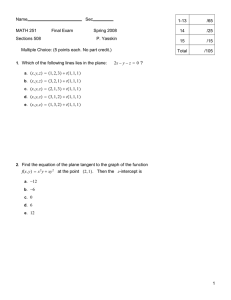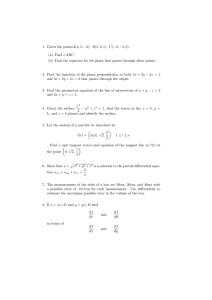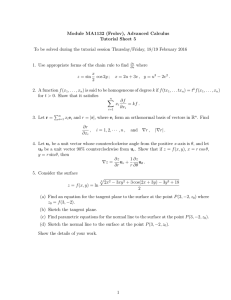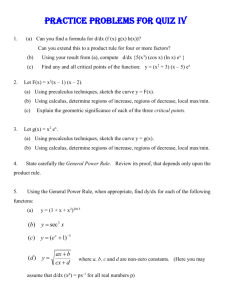Name Sec 1-13 /65
advertisement
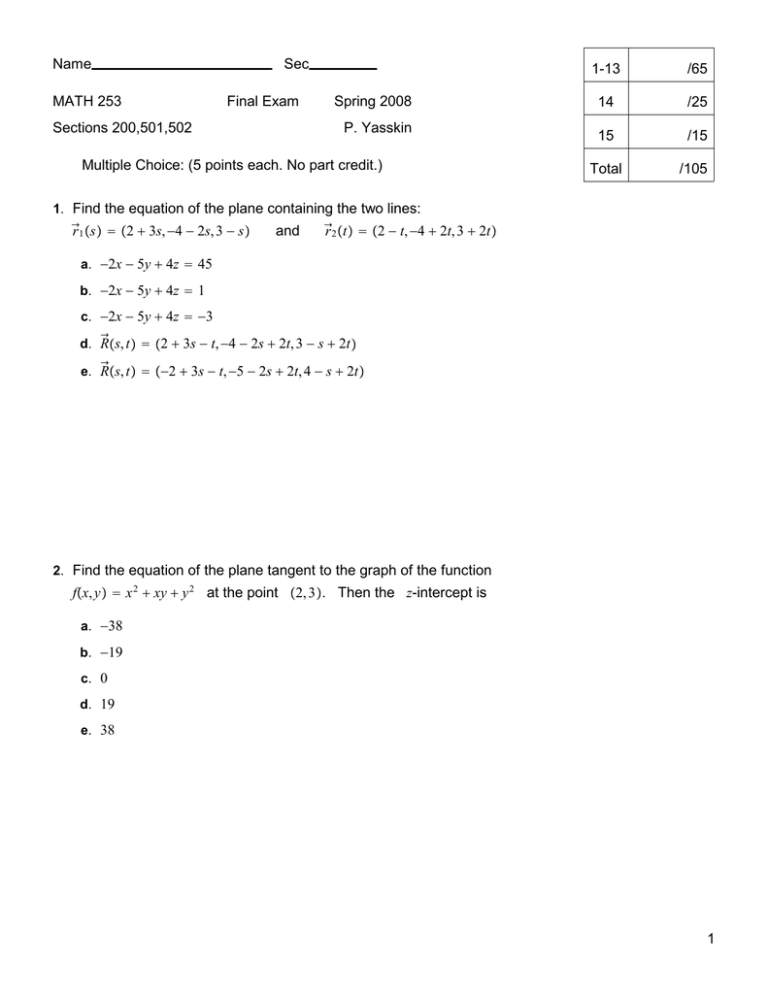
Name MATH 253 Sec Final Exam Sections 200,501,502 Spring 2008 P. Yasskin Multiple Choice: (5 points each. No part credit.) 1-13 /65 14 /25 15 /15 Total /105 1. Find the equation of the plane containing the two lines: ⃗r 1 s = 2 + 3s, −4 − 2s, 3 − s and ⃗r 2 t = 2 − t, −4 + 2t, 3 + 2t a. −2x − 5y + 4z = 45 b. −2x − 5y + 4z = 1 c. −2x − 5y + 4z = −3 ⃗ s, t = 2 + 3s − t, −4 − 2s + 2t, 3 − s + 2t d. R ⃗ s, t = −2 + 3s − t, −5 − 2s + 2t, 4 − s + 2t e. R 2. Find the equation of the plane tangent to the graph of the function fx, y = x 2 + xy + y 2 at the point 2, 3. Then the z-intercept is a. −38 b. −19 c. 0 d. 19 e. 38 1 3. Find the arc length of the curve ⃗ rt = ln t, 2t, t 2 between 0, 2, 1 and 1, 2e, e 2 . Hint: Look for a perfect square. a. e 2 b. 1 + e 2 c. e 2 − 1 d. 2 + e 2 e. e 2 − 2 ̂ of the curve ⃗rt = ln t, 2t, t 2 at t = 1. 4. Find the unit binormal B Hint: a. b. c. d. e. Plug t = 1 into ⃗v and ⃗ a. 2, 3 1, 3 1, 3 2, 3 2, 3 1, 2 3 3 2, 2 3 3 −2 , 2 3 3 2, 1 3 3 −2 , 1 3 3 2 5. The volume of a square pyramid is V = 1 s 2 h. 3 If the side of the base s is currently 3 cm and increasing at 2 cm/sec while the height h is currently 4 cm and decreasing at 1 cm/sec, is the volume increasing or decreasing and at what rate? a. increasing at 19 cm 3 / sec b. increasing at 13 cm 3 / sec c. neither increasing nor decreasing d. decreasing at 13 cm 3 / sec e. decreasing at 19 cm 3 / sec 6. Which of the following is a local minimum of fx, y = sinx cosy? a. 0, 0 b. π ,0 2 c. π, π d. 0, π 2 e. None of the above 3 7. Find the equation of the plane tangent to the surface x 2 z 2 + yz 3 = 11 at the point 2, 3, 1. Then the intersection with the x-axis is at a. 28, 0, 0 b. 16, 0, 0 c. 14, 0, 0 d. 7, 0, 0 e. 4, 0, 0 8. Compute ∫ F⃗ ⋅ ds⃗ ⃗ = y, x for the vector field F along the curve ⃗rt = t + sin t, t + cos t from ⃗rπ to ⃗r2π. Hint: Find a scalar potential. a. 3π 2 + 3π b. 3π 2 − 3π c. 3π 2 + π d. 3π 2 − π e. 3π − 3π 2 4 9. Find the mass of the solid hemisphere x 2 + y 2 + z 2 ≤ 4 for y ≥ 0 if the density is δ = z 2 . a. 4 π 2 b. c. d. e. 3 8 π2 3 32π 15 64π 15 128π 15 10. Find the center of mass of the solid hemisphere x 2 + y 2 + z 2 ≤ 4 for y ≥ 0 if the density is δ = z 2 . a. b. c. d. e. 0, 5 , 0 8 0, 8 , 0 5 0, 8π , 0 3 0, 3 , 0 8π 0, 3 , 0 4π 5 11. Find the area inside the circle r = 1 but outside the cardioid r = 1 − cos θ. a. π 4 b. π 2 c. 2 − π 4 d. 2 + π 4 e. 2 − π 2 12. Compute ∮ ⃗∇f ⋅ ds⃗ y counterclockwise once 2 around the polar curve r = 3 − cos4θ for the function fx, y = x 2 y. -2 2 x a. 2π -2 b. 4π c. 6π d. 8π e. 0 6 13. Stokes’ Theorem states ∫∫ ⃗∇ × F⃗ ⋅ dS⃗ = ∮ F⃗ ⋅ ds⃗ C ∂C Compute either integral for the cone C given by z = 2 x2 + y2 for z ≤ 8 oriented up and in, ⃗ = yz, −xz, z. and the vector field F ⃗ r, θ = r cos θ, r sin θ, 2r Note: The cone may be parametrized as R The boundary of the cone is the circle x 2 + y 2 = 16 with z = 8. a. −768π b. −256π c. 64π d. 256π e. 768π 7 Work Out: (Part credit possible. Show all work.) 14. ∫∫∫ ⃗∇ ⋅ F⃗ dV = ∫∫ F⃗ ⋅ dS⃗ (25 points) Verify Gauss’ Theorem H for the solid hemisphere and the vector field ∂H x + y + z ≤ 4 with z ≥ 0 2 2 2 ⃗ = xz 2 , yz 2 , x 2 + y 2 . F Notice that the boundary of the solid hemisphere ∂H consists of the hemisphere surface S given by x 2 + y 2 + z 2 = 4 with z ≥ 0 and the disk D given by x 2 + y 2 ≤ 4 with z = 0. Be sure to check and explain the orientations. Use the following steps: a. Compute the volume integral by successively finding: ⃗ ⃗ x, y, z, ⃗ ⃗ ρ, θ, ϕ, dV, ∇⋅F ∇⋅F ∫∫∫ ⃗∇ ⋅ F⃗ dV H b. Compute the surface integral over the disk by parametrizing the disk and successively finding: ⃗ r, θ, ⃗e r , ⃗e θ , N ⃗, F ⃗ R ⃗ r, θ , R ∫∫ F⃗ ⋅ dS⃗ D 8 Recall: ⃗ = xz 2 , yz 2 , x 2 + y 2 F c. Compute the surface integral over the hemisphere by parametrizing the surface and successively finding: ⃗ θ, ϕ, ⃗e θ , ⃗e ϕ , N ⃗, F ⃗ R ⃗ θ, ϕ , R ∫∫ F⃗ ⋅ dS⃗ S d. Combine ∫∫ F⃗ ⋅ dS⃗ D and ∫∫ F⃗ ⋅ dS⃗ S to get ∫∫ F⃗ ⋅ dS⃗ ∂H 9 15. (15 points) A rectangular solid sits on the xy-plane with its top four vertices on the paraboloid z = 9 − 9x 2 − y 2 . Find the dimensions and volume of the largest such box. 10 16. (5 points) (Honors only. Replaces #2.) Find the plane tangent to the parametric surface ⃗ u, v = u + v, u − v, uv at the point R ⃗ 1, 1 = 2, 0, 1. R Give both the parametric equation and the normal equation of the tangent plane. 11
